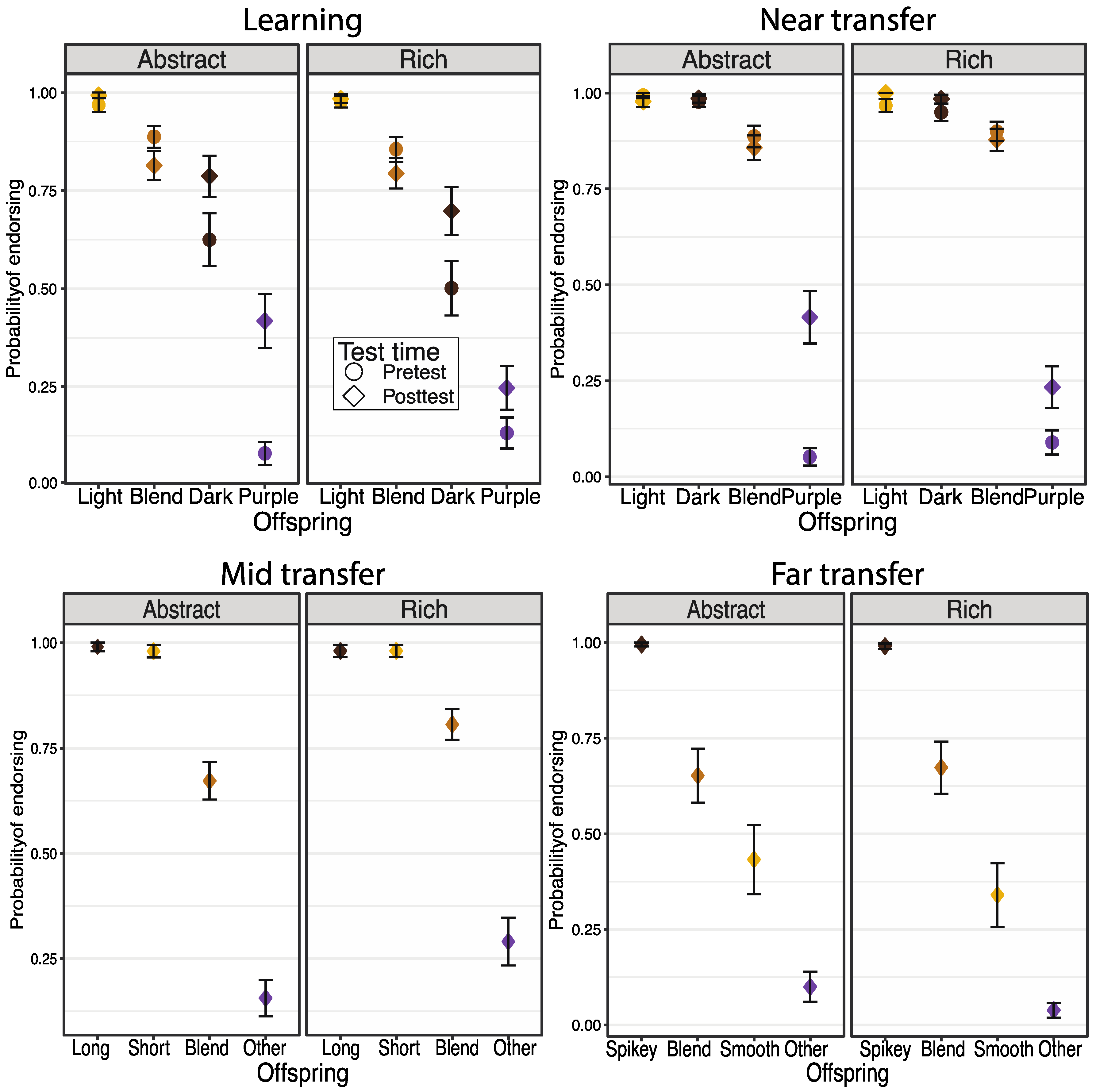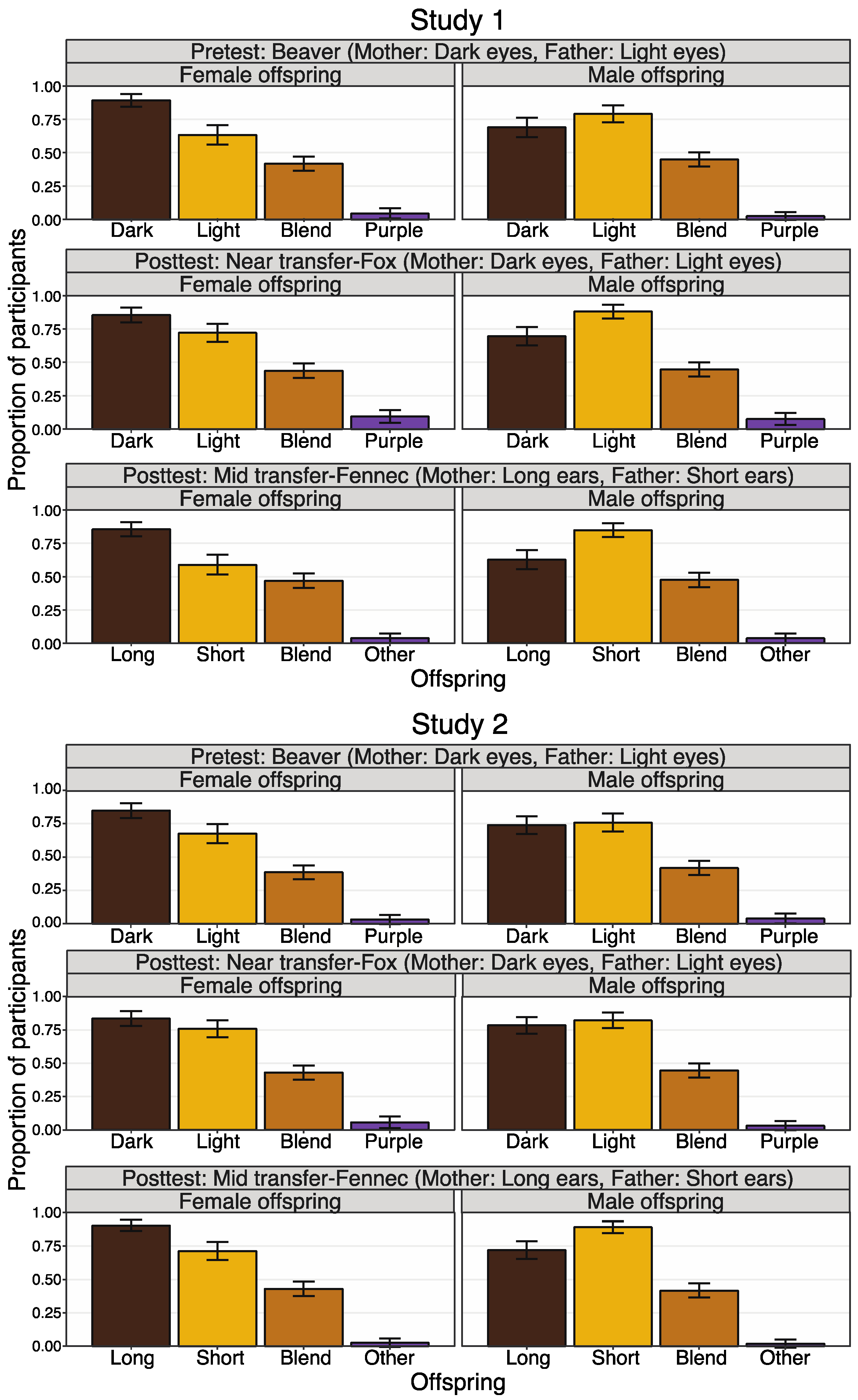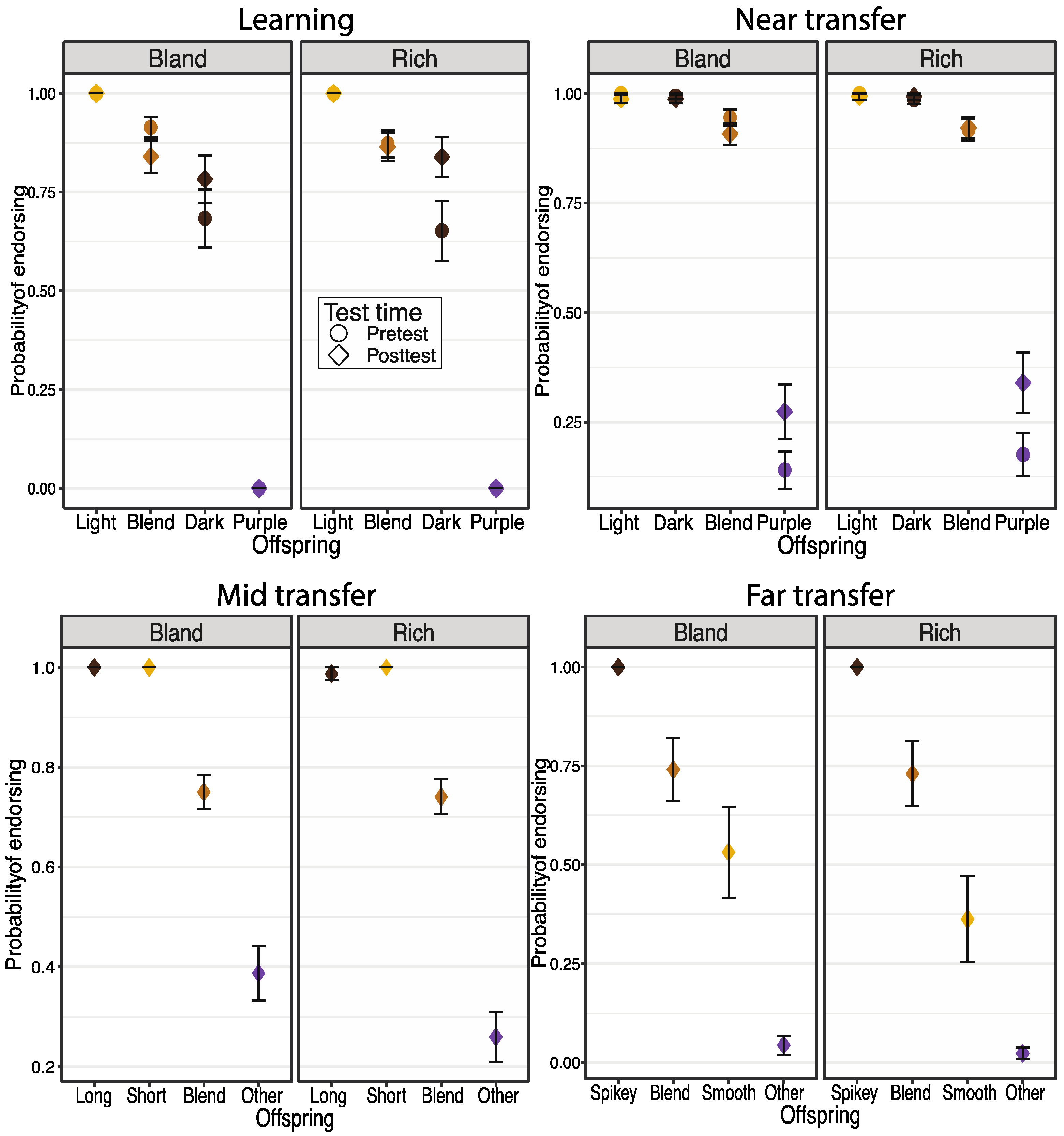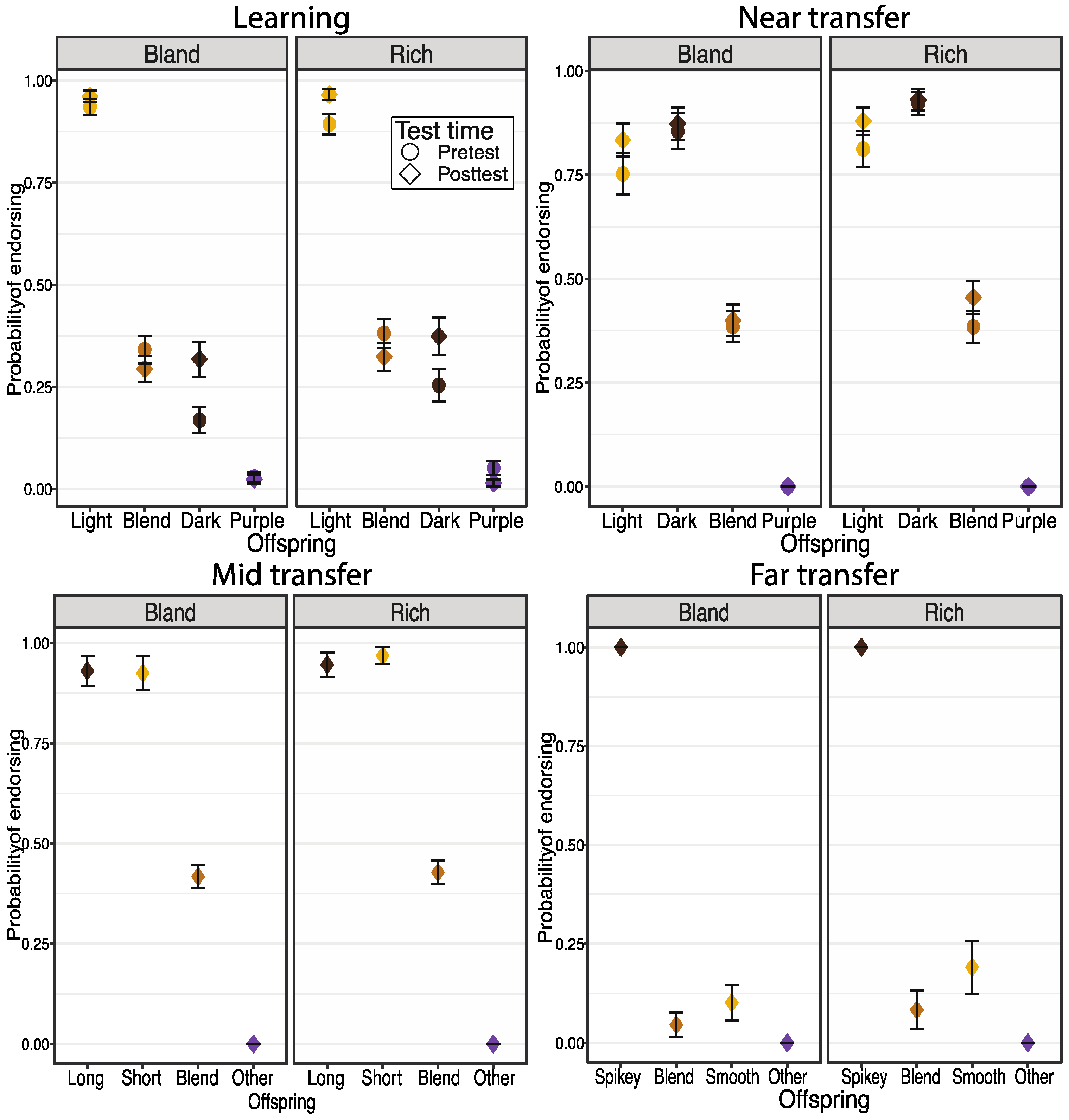The Role of Visual Representations in Undergraduate Students’ Learning about Genetic Inheritance
Abstract
:1. Introduction
2. Understanding of Genetics
3. Visual Representations in Biology Education
4. Current Studies
5. Study 1: Rich vs. Abstract Visual Representations
5.1. Method
5.1.1. Participants
5.1.2. Design
5.1.3. Procedure
5.1.4. Materials
5.1.5. Data Analytic Strategy
5.2. Results
5.2.1. Pre-Registered Analyses
Phenotypic Judgment Task
Offspring Prediction Task
Post-Hoc Analyses
5.3. Discussion
6. Study 2: Rich versus Bland Diagrams
6.1. Method
6.1.1. Participants
6.1.2. Design and Procedure
6.1.3. Data Analytic Strategy
6.2. Results
6.2.1. Pre-Registered Analyses
Phenotypic Judgment Task
Offspring Prediction Task
6.2.2. Post-Hoc Analyses
6.3. Discussion
7. General Discussion
8. Implications for Understanding Genetics
9. Limitations
10. Conclusions
Author Contributions
Funding
Institutional Review Board Statement
Informed Consent Statement
Data Availability Statement
Conflicts of Interest
References
- Batzli, J.M.; Smith, A.R.; Williams, P.H.; McGee, S.A.; Dósa, K.; Pfammatter, J. Beyond Punnett Squares: Student Word Association and Explanations of Phenotypic Variation through an Integrative Quantitative Genetics Unit Investigating Anthocyanin Inheritance and Expression in Brassica rapa Fast Plants. CBE Life Sci. Educ. 2014, 13, 410–424. [Google Scholar] [CrossRef]
- Batzli, J.M.; Knight, J.K.; Hartley, L.M.; Maskiewicz, A.C.; Desy, E.A. Crossing the Threshold: Bringing Biological Variation to the Foreground. CBE Life Sci. Educ. 2016, 15, es9. [Google Scholar] [CrossRef]
- Emmons, N.; Lees, K.; Kelemen, D. Young Children’s Near and Far Transfer of the Basic Theory of Natural Selection: An Analogical Storybook Intervention. J. Res. Sci. Teach. 2018, 55, 321–347. [Google Scholar] [CrossRef]
- NGSS Lead States. Next Generation Science Standards: For States, By States; The National Academies Press: Washington, DC, USA, 2013; ISBN 978-0-309-27227-8. [Google Scholar]
- APEC Human Resource Development Working Group. Analysis of Mathematics and Science Standards from the Asia-Pacific Economic Cooperation 2009; APEC Secretariat: Washington, DC, USA, 2011. [Google Scholar]
- OECD. PISA 2021 Technical Standards; OECD: Paris, France, 2018; Volume 25. [Google Scholar]
- Stern, F.; Delaval, M.; Kampourakis, K.; Müller, A. Implicit Associations of Teleology and Essentialism Concepts with Genetics Concepts among Secondary School Students. PLoS ONE 2020, 15, e0242189. [Google Scholar] [CrossRef]
- Stern, F.; Kampourakis, K.; Müller, A. “Genes for a Role,” “Genes as Essences”: Secondary Students’ Explicit and Implicit Intuitions about Genetic Essentialism and Teleology. J. Res. Sci. Teach. 2023, 60, 237–267. [Google Scholar] [CrossRef]
- Stern, F.; Kampourakis, K. Teaching for Genetics Literacy in the Post-Genomic Era. Stud. Sci. Educ. 2017, 53, 193–225. [Google Scholar] [CrossRef]
- Kaminske, A.N.; Kuepper-Tetzel, C.E.; Nebel, C.L.; Sumeracki, M.A.; Ryan, S.P. Transfer: A Review for Biology and the Life Sciences. CBE Life Sci. Educ. 2020, 19, es9. [Google Scholar] [CrossRef]
- Newman, D.L.; Catavero, C.M.; Wright, L.K. Students Fail to Transfer Knowledge of Chromosome Structure to Topics Pertaining to Cell Division. CBE Life Sci. Educ. 2012, 11, 425–436. [Google Scholar] [CrossRef]
- Mayer, R.E. Multimedia Learning, 2nd ed.; Cambridge University Press: Cambridge, UK; New York, NY, USA, 2009; ISBN 978-0-521-51412-5. [Google Scholar]
- Solomon, G.E.A. Birth, Kind and Naïve Biology. Dev. Sci. 2002, 5, 213–218. [Google Scholar] [CrossRef]
- Solomon, G.E.A.; Johnson, S.C.; Zaitchik, D.; Carey, S. Like Father, Like Son: Young Children’s Understanding of How and Why Offspring Resemble Their Parents. Child Dev. 1996, 67, 151–171. [Google Scholar] [CrossRef]
- Williams, J.M. Children and Adolescents’ Understandings of Family Resemblance: A Study of Naïve Inheritance Concepts: Phenotypic Similarity and Difference. Br. J. Dev. Psychol. 2012, 30, 225–252. [Google Scholar] [CrossRef]
- Coley, J.D.; Tanner, K.D. Common Origins of Diverse Misconceptions: Cognitive Principles and the Development of Biology Thinking. CBE Life Sci. Educ. 2012, 11, 209–215. [Google Scholar] [CrossRef]
- Gelman, S.A.; Rhodes, M. “Two-Thousand Years of Stasis”: How Psychological Essentialism Impedes Evolutionary Understanding. In Evolution Challenges: Integrating Research and Practice in Teaching and Learning about Evolution; Rosengren, K.S., Brem, S.K., Evans, E.M., Sinatra, G.M., Eds.; Oxford University Press: Oxford, UK, 2012. [Google Scholar]
- Kelemen, D. Teleological Minds: How Natural Intuitions about Agency and Purpose Influence Learning about Evolution. In Evolution Challenges: Integrating Research and Practice in Teaching and Learning about Evolution; Rosengren, K.S., Brem, S.K., Evans, E.M., Sinatra, G.M., Eds.; Oxford University Press: Oxford, UK, 2012; pp. 66–92. [Google Scholar]
- Kelemen, D.; Rottman, J.; Seston, R. Professional Physical Scientists Display Tenacious Teleological Tendencies: Purpose-Based Reasoning as a Cognitive Default. J. Exp. Psychol. Gen. 2013, 142, 1074–1083. [Google Scholar] [CrossRef]
- Coley, J.D.; Arenson, M.; Xu, Y.; Tanner, K.D. Intuitive Biological Thought: Developmental Changes and Effects of Biology Education in Late Adolescence. Cognit. Psychol. 2017, 92, 1–21. [Google Scholar] [CrossRef]
- Menendez, D.; Mathiaparanam, O.N.; Seitz, V.; Liu, D.; Donovan, A.M.; Kalish, C.W.; Alibali, M.W.; Rosengren, K.S. Like Mother, like Daughter: Adults’ Judgments about Genetic Inheritance. J. Exp. Psychol. Appl. 2023, 29, 63. [Google Scholar] [CrossRef]
- Menendez, D.; Donovan, A.M.; Mathiaparanam, O.N.; Seitz, V.; Sabbagh, N.F.; Klapper, R.E.; Kalish, C.W.; Rosengren, K.S.; Alibali, M.W. Deterministic or Probabilistic: U.S. Children’s Beliefs about Genetic Inheritance. Child Dev. 2024. [Google Scholar] [CrossRef]
- Godwin, K.E.; Leroux, A.J.; Seltman, H.; Scupelli, P.; Fisher, A.V. Effect of Repeated Exposure to the Visual Environment on Young Children’s Attention. Cogn. Sci. 2022, 46, e13093. [Google Scholar] [CrossRef]
- Woodward, A. Do Illustrations Serve an Instructional Purpose in U.S. Textbooks? In Learning from Textbooks: Theory and Practice; Britton, B.K., Binkley, M., Woodward, A., Binkley, M.R., Eds.; Psychology Press: London, UK, 1993; pp. 115–134. ISBN 978-0-8058-0677-9. [Google Scholar]
- Menendez, D. Cues to Generality: Integrating Linguistic and Visual Information When Generalizing Biological Information. J. Educ. Psychol. 2023, 115, 1110–1124. [Google Scholar] [CrossRef]
- Menendez, D.; Mathiaparanam, O.N.; Liu, D.; Seitz, V.; Alibali, M.W.; Rosengren, K.S. Representing Variability: The Case of Life Cycle Diagrams. CBE Life Sci. Educ. 2020, 19, ar49. [Google Scholar] [CrossRef]
- Wiley, J.; Sarmento, D.; Griffin, T.D.; Hinze, S.R. Biology Textbook Graphics and Their Impact on Expectations of Understanding. Discourse Process. 2017, 54, 463–478. [Google Scholar] [CrossRef]
- Wright, L.K.; Fisk, J.N.; Newman, D.L. DNA → RNA: What Do Students Think the Arrow Means? CBE Life Sci. Educ. 2014, 13, 338–348. [Google Scholar] [CrossRef]
- Kaminski, J.A.; Sloutsky, V.M.; Heckler, A.F. The Cost of Concreteness: The Effect of Nonessential Information on Analogical Transfer. J. Exp. Psychol. Appl. 2013, 19, 14–29. [Google Scholar] [CrossRef]
- Fisher, A.V.; Godwin, K.E.; Seltman, H. Visual Environment, Attention Allocation, and Learning in Young Children: When Too Much of a Good Thing May Be Bad. Psychol. Sci. 2014, 25, 1362–1370. [Google Scholar] [CrossRef]
- Harp, S.F.; Mayer, R.E. How Seductive Details Do Their Damage: A Theory of Cognitive Interest in Science Learning. J. Educ. Psychol. 1998, 90, 414–434. [Google Scholar] [CrossRef]
- Morita, A.; Fukuya, I. Impact of Decorative Pictures in Learning Materials: The Effect of Attention-Grabbing Features. Appl. Cogn. Psychol. 2023, 37, 1352–1365. [Google Scholar] [CrossRef]
- Skulmowski, A.; Rey, G.D. Realistic Details in Visualizations Require Color Cues to Foster Retention. Comput. Educ. 2018, 122, 23–31. [Google Scholar] [CrossRef]
- Abercrombie, S. Transfer Effects of Adding Seductive Details to Case-Based Instruction. Contemp. Educ. Psychol. 2013, 38, 149–157. [Google Scholar] [CrossRef]
- Eitel, A.; Bender, L.; Renkl, A. Are Seductive Details Seductive Only When You Think They Are Relevant? An Experimental Test of the Moderating Role of Perceived Relevance. Appl. Cogn. Psychol. 2019, 33, 20–30. [Google Scholar] [CrossRef]
- Skulmowski, A.; Rey, G.D. Realism as a Retrieval Cue: Evidence for Concreteness-specific Effects of Realistic, Schematic, and Verbal Components of Visualizations on Learning and Testing. Hum. Behav. Emerg. Technol. 2020, 3, 283–295. [Google Scholar] [CrossRef]
- Skulmowski, A.; Rey, G.D. The Realism Paradox: Realism Can Act as a Form of Signaling despite Being Associated with Cognitive Load. Hum. Behav. Emerg. Technol. 2020, 2, 251–258. [Google Scholar] [CrossRef]
- Goldstone, R.L.; Sakamoto, Y. The Transfer of Abstract Principles Governing Complex Adaptive Systems. Cognit. Psychol. 2003, 46, 414–466. [Google Scholar] [CrossRef]
- Goldstone, R.L.; Son, J.Y. The Transfer of Scientific Principles Using Concrete and Idealized Simulations. J. Learn. Sci. 2005, 14, 69–110. [Google Scholar] [CrossRef]
- Kaminski, J.A.; Sloutsky, V.M.; Heckler, A.F. The Advantage of Abstract Examples in Learning Math. Science 2008, 320, 454–455. [Google Scholar] [CrossRef] [PubMed]
- Gentner, D. Structure-Mapping: A Theoretical Framework for Analogy. Cogn. Sci. 1983, 7, 155–170. [Google Scholar] [CrossRef]
- Rau, M.A. How Do Students Learn to See Concepts in Visualizations? Social Learning Mechanisms with Physical and Virtual Representations. J. Learn. Anal. 2017, 4, 240–263. [Google Scholar] [CrossRef]
- Stieff, M. Improving Representational Competence Using Molecular Simulations Embedded in Inquiry Activities. J. Res. Sci. Teach. 2011, 48, 1137–1158. [Google Scholar] [CrossRef]
- Wright, L.K.; Cardenas, J.J.; Liang, P.; Newman, D.L. Arrows in Biology: Lack of Clarity and Consistency Points to Confusion for Learners. CBE Life Sci. Educ. 2018, 17, ar6. [Google Scholar] [CrossRef] [PubMed]
- Nitz, S.; Ainsworth, S.E.; Nerdel, C.; Prechtl, H. Do Student Perceptions of Teaching Predict the Development of Representational Competence and Biological Knowledge? Learn. Instr. 2014, 31, 13–22. [Google Scholar] [CrossRef]
- Stieff, M.; Scopelitis, S.; Lira, M.E.; Desutter, D. Improving Representational Competence with Concrete Models: IMPROVING REPRESENTATIONAL COMPETENCE. Sci. Educ. 2016, 100, 344–363. [Google Scholar] [CrossRef]
- De Bock, D.; Deprez, J.; Van Dooren, W.; Roelens, M.; Verschaffel, L. Abstract or Concrete Examples in Learning Mathematics? A Replication and Elaboration of Kaminski, Sloutsky, and Heckler’s Study. J. Res. Math. Educ. 2011, 42, 109–126. [Google Scholar] [CrossRef]
- Trninic, D.; Kapur, M.; Sinha, T. The Disappearing “Advantage of Abstract Examples in Learning Math”. Cogn. Sci. 2020, 44, e12851. [Google Scholar] [CrossRef]
- Menendez, D.; Rosengren, K.S.; Alibali, M.W. Do Details Bug You? Effects of Perceptual Richness in Learning about Biological Change. Appl. Cogn. Psychol. 2020, 34, 1101–1117. [Google Scholar] [CrossRef]
- Menendez, D.; Sabbagh, N.F.; Alibali, M.W.; Rosengren, K.S. Timelines or Time Cycles: Exposure to Different Spatial Representations of Time Influences Sketching and Diagram Preferences. Educ. Res. Policy Pract. 2023, 1–19. [Google Scholar] [CrossRef]
- Butcher, K.R. Learning from Text with Diagrams: Promoting Mental Model Development and Inference Generation. J. Educ. Psychol. 2006, 98, 182–197. [Google Scholar] [CrossRef]
- Skulmowski, A. Is There an Optimum of Realism in Computer-Generated Instructional Visualizations? Educ. Inf. Technol. 2022, 27, 10309–10326. [Google Scholar] [CrossRef]
- Skulmowski, A. Realistic Visualizations Can Aid Transfer Performance: Do Distinctive Shapes and Descriptive Labels Contribute towards Learning? J. Comput. Assist. Learn. 2022, 38, 681–691. [Google Scholar] [CrossRef]
- Klahr, D.; Chen, Z. Findings One’s Place in Transfer Space. Child Dev. Perspect. 2011, 5, 196–204. [Google Scholar] [CrossRef]
- Mathiaparanam, O.N.; Donovan, A.; Menendez, D.; Jones, C.; Yoo, S.H.; Alibali, M.W.; Kalish, C.W.; Rosengren, K. Perceptual Features in Visual Representations: A Content Analysis of Inheritance Diagrams. Proc. Annu. Meet. Cogn. Sci. Soc. 2022, 44, 4061. [Google Scholar]
- Duncan, R.G.; Rogat, A.D.; Yarden, A. A Learning Progression for Deepening Students’ Understandings of Modern Genetics across the 5th–10th Grades. J. Res. Sci. Teach. 2009, 46, 655–674. [Google Scholar] [CrossRef]
- Brauer, M.; Curtin, J.J. Linear Mixed-Effects Models and the Analysis of Nonindependent Data: A Unified Framework to Analyze Categorical and Continuous Independent Variables That Vary within-Subjects and/or within-Items. Psychol. Methods 2018, 23, 389–411. [Google Scholar] [CrossRef]
- DeLoache, J.S. Becoming Symbol-Minded. Trends Cogn. Sci. 2004, 8, 66–70. [Google Scholar] [CrossRef]
- DeLoache, J.; Peralta, O.; Anderson, K.N. Multiple Factors in Early Symbol Use—A Theory of the Development of Deliberate Reasoning and Intentional Action. Cogn. Dev. 1999, 14, 299–312. [Google Scholar] [CrossRef]
- DeLoache, J.S.; Uttal, D.H.; Pierroutsakos, S.L. The Development of Early Symbolization: Educational Implications. Learn. Instr. 1998, 8, 325–339. [Google Scholar] [CrossRef]
- Chandler, P.; Sweller, J. Cognitive Load Theory and the Format of Instruction. Cogn. Instr. 1991, 8, 293–332. [Google Scholar] [CrossRef]
- Mayer, R.E.; Moreno, R. Nine Ways to Reduce Cognitive Load in Multimedia Learning. Educ. Psychol. 2003, 38, 43–52. [Google Scholar] [CrossRef]
- Skulmowski, A.; Xu, K.M. Understanding Cognitive Load in Digital and Online Learning: A New Perspective on Extraneous Cognitive Load. Educ. Psychol. Rev. 2021, 34, 171–196. [Google Scholar] [CrossRef]
- Ainsworth, S. The Educational Value of Multiple-Representations When Learning Complex Scientific Concepts. In Visualization: Theory and Practice in Science Education; Gilbert, J., Reiner, M., Nakhleh, M.B., Eds.; Models and Modeling in Science Education; Springer: New York, NY, USA, 2008; pp. 191–208. ISBN 978-1-4020-5266-8. [Google Scholar]
- Donovan, B.M. Framing the Genetics Curriculum for Social Justice: An Experimental Exploration of How the Biology Curriculum Influences Beliefs About Racial Difference. Sci. Educ. 2016, 100, 586–616. [Google Scholar] [CrossRef]
- Donovan, B.M.; Weindling, M.; Salazar, B.; Duncan, A.; Stuhlsatz, M.; Keck, P. Genomics Literacy Matters: Supporting the Development of Genomics Literacy through Genetics Education Could Reduce the Prevalence of Genetic Essentialism. J. Res. Sci. Teach. 2021, 58, 520–550. [Google Scholar] [CrossRef]
- Clinton, V.; Morsanyi, K.; Alibali, M.W.; Nathan, M.J. Learning about Probability from Text and Tables: Do Color Coding and Labeling through an Interactive-User Interface Help? Appl. Cogn. Psychol. 2016, 30, 440–453. [Google Scholar] [CrossRef]
- Betz, N.; Leffers, J.S.; Thor, E.E.D.; Fux, M.; de Nesnera, K.; Tanner, K.D.; Coley, J.D. Cognitive Construal-Consistent Instructor Language in the Undergraduate Biology Classroom. CBE Life Sci. Educ. 2019, 18, ar63. [Google Scholar] [CrossRef]
- Kelemen, D. The Magic of Mechanism: Explanation-Based Instruction on Counterintuitive Concepts in Early Childhood. Perspect. Psychol. Sci. 2019, 14, 510–522. [Google Scholar] [CrossRef] [PubMed]
- Harsh, J.A.; Campillo, M.; Murray, C.; Myers, C.; Nguyen, J.; Maltese, A.V. “Seeing” Data like an Expert: An Eye-Tracking Study Using Graphical Data Representations. CBE Life Sci. Educ. 2019, 18, ar32. [Google Scholar] [CrossRef]
- Sanchez, C.A.; Wiley, J. An Examination of the Seductive Details Effect in Terms of Working Memory Capacity. Mem. Cognit. 2006, 34, 344–355. [Google Scholar] [CrossRef]






Disclaimer/Publisher’s Note: The statements, opinions and data contained in all publications are solely those of the individual author(s) and contributor(s) and not of MDPI and/or the editor(s). MDPI and/or the editor(s) disclaim responsibility for any injury to people or property resulting from any ideas, methods, instructions or products referred to in the content. |
© 2024 by the authors. Licensee MDPI, Basel, Switzerland. This article is an open access article distributed under the terms and conditions of the Creative Commons Attribution (CC BY) license (https://creativecommons.org/licenses/by/4.0/).
Share and Cite
Menendez, D.; Donovan, A.M.; Mathiaparanam, O.N.; Klapper, R.E.; Yoo, S.H.; Rosengren, K.S.; Alibali, M.W. The Role of Visual Representations in Undergraduate Students’ Learning about Genetic Inheritance. Educ. Sci. 2024, 14, 307. https://doi.org/10.3390/educsci14030307
Menendez D, Donovan AM, Mathiaparanam ON, Klapper RE, Yoo SH, Rosengren KS, Alibali MW. The Role of Visual Representations in Undergraduate Students’ Learning about Genetic Inheritance. Education Sciences. 2024; 14(3):307. https://doi.org/10.3390/educsci14030307
Chicago/Turabian StyleMenendez, David, Andrea Marquardt Donovan, Olympia N. Mathiaparanam, Rebecca E. Klapper, Seung Heon Yoo, Karl S. Rosengren, and Martha W. Alibali. 2024. "The Role of Visual Representations in Undergraduate Students’ Learning about Genetic Inheritance" Education Sciences 14, no. 3: 307. https://doi.org/10.3390/educsci14030307





